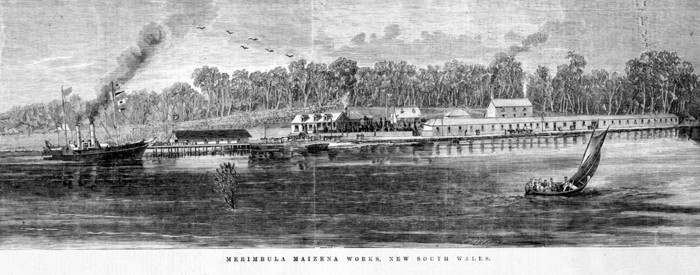South Coast NSW History Story
Munn's Maizena
Munn’s Maizena
A mill was erected by David Kirkwood in Merimbula in 1858 to produce flour from wheat. When it was discovered that the local area was not suitable for growing wheat, Kirkwood’s mill ceased production.
Matthew Munn, an experienced miller from Melbourne, purchased the old mill in 1865 with support from Thomas Mort and Twofold Pastoral Association member Sir William Montagu Manning (Merimbula was originally a privately owned township built by the Twofold Bay Association). He converted it to mill corn that grew in abundance in surrounding areas. By the time production started in 1867, Munn had spent £10,000 on the mill and other impressive associated buildings that ran along the Merimbula waterfront.
Initially 3 tons of Munn’s ‘Maizena’ (cornflour) were produced per week. This ultimately increased to a ton per day, with Munns Maizena Works employing 40 to 50 people. Waste ‘corn bran’ was fed to pigs, 500 of which were penned in a yard behind the mill for fattening, prior to being turned into bacon or ham.
The factory became one of the most commercially important establishments on the NSW South Coast.
Prior to the establishment of Munn’s Maizena Works, most of the cornflour used in Australia was supplied from overseas. But ‘by virtue of its own excellence and the advantages of a home market, it (Munn’s Maizena) has superseded imported maizena, and in addition to that, the price of the article now used in the Australian colonies, and manufactured at Merimbula, is much lower than it was when colonial-made maizena was first offered to the public.’
Matthew Munn died in 1873 with the Bega Gazette noting he ‘belonged to a class the colony can ill afford to lose. Shrewd and enterprising he made a fine business by the manufacture of the article ‘Maizena’, which has not only stood its ground by the side of the English and American manufacture of a similar sort, but has almost driven both these from the market’.
The business was continued by his son, Armstrong, for whom Matthew Munn was building ‘Courunga’ as a wedding gift at the time of his death. (Courunga, or Munn’s Tower House as it is locally known, was extended in 1882. Today it is a distinctive feature on Merimbula’s skyline.)
In 1903 it was reported that ‘Mr. Munn has decided to double his plant...in order to increase the output (and) has found business so brisk that he is compelled to enlarge his premises and work double shifts’. A year later, the factory was reportedly ‘going day and night to fulfill demands which come from all parts of Australia and New Zealand’.
In 1913 the business changed hands. Almost immediately, the new proprietor, a Mr. James Channon, closed the factory down to enable extensions to be added. The business appears to have never recovered from this and in 1918 it was announced that Merimbula’s Maizena Works had ceased operations.
And (unlike Arnott’s biscuits and Kirks soft drinks that were also first produced in 1865, and have survived), the once-popular Munn’s Maziena brand was simply consigned to a grocery store graveyard.
Image: Munn's Maizena Works in 1869.
